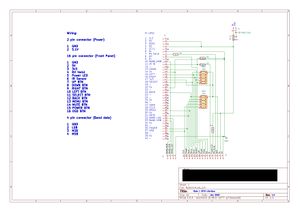Difference between revisions of "Ryde GPIO breakout"
| (3 intermediate revisions by 2 users not shown) | |||
| Line 9: | Line 9: | ||
* Note the GPIO board requires 5v NOT 12v! | * Note the GPIO board requires 5v NOT 12v! | ||
| − | * The GPIO header is placed on the opposite side of the PCB to the rest of the components (but see below - upside down construction). | + | * The GPIO header '''is placed on the opposite side of the PCB''' to the rest of the components (but see below - upside down construction). |
| − | * Pay attention to the orientation of the resistor arrays - | + | * Pay attention to the orientation of the resistor arrays - the packages are not symmetrical. |
* Build the top side first, start with the resistors, then the resistor arrays, then the 16 way, then the headers, finally fit the 40 way on the other side of the PCB. | * Build the top side first, start with the resistors, then the resistor arrays, then the 16 way, then the headers, finally fit the 40 way on the other side of the PCB. | ||
| Line 17: | Line 17: | ||
* The fuse is a standard automotive mini-blade, 3A. Take care inserting it as it requires considerable force. You may need to open up the socket a little. | * The fuse is a standard automotive mini-blade, 3A. Take care inserting it as it requires considerable force. You may need to open up the socket a little. | ||
| − | + | ==Schematic and bill of materials== | |
| Line 74: | Line 74: | ||
===Upside-down construction=== | ===Upside-down construction=== | ||
| − | If, for mechanical reasons, you want to put all the components on the underside of the GPIO breakout, you need to remember that the header pin connections will be reversed. The most important one to get right is the Power + and -. However, you will also need to modify the ribbon cable to the front panel as shown in this photo. | + | If, for mechanical reasons, you want to put all the components on the underside of the GPIO breakout, '''you need to remember that the header pin connections will be reversed.''' The most important one to get right is the Power + and -. However, you will also need to modify the ribbon cable to the front panel as shown in this photo. |
[[File:Ryde Reversed Ribbon.jpg|400px]] | [[File:Ryde Reversed Ribbon.jpg|400px]] | ||
The ribbon connector was opened up, each odd/even pair reversed, and then the connector closed again. | The ribbon connector was opened up, each odd/even pair reversed, and then the connector closed again. | ||
Latest revision as of 15:04, 12 December 2020
To help constructors connect easily to the Ryde RPIO, BATC has produced a small daughter board.
PCBs are available in the BATC shop - https://batc.org.uk/shop/ryde-gpio-pcb/
Construction notes
- Note the GPIO board requires 5v NOT 12v!
- The GPIO header is placed on the opposite side of the PCB to the rest of the components (but see below - upside down construction).
- Pay attention to the orientation of the resistor arrays - the packages are not symmetrical.
- Build the top side first, start with the resistors, then the resistor arrays, then the 16 way, then the headers, finally fit the 40 way on the other side of the PCB.
- The fuse is a standard automotive mini-blade, 3A. Take care inserting it as it requires considerable force. You may need to open up the socket a little.
Schematic and bill of materials
Nothing is really critical here so don't worry about 47k vs 10k vs 22k resistor arrays.
What does matter is the IR sensor does not put more than 3.3V into the GPIO as the PI is not 5V tolerant. Therefore either use a 3.3V sensor as recommended, or if you insist on re-using that old sensor recovered from a set top box make a resistor divider using appropriate resistors. See https://wiki.batc.org.uk/Ryde_remote_controls for more details
Farnell part numbers: Other suppliers are available.
IR Sensor - TSOP2438 Farnell code 4913097 Run off 3.3V R3 4k7, omit R2.
For 5V sensors possibly [ADVICE DELETED - USE a 3.3V SENSOR]
SIP Resistor arrays 10k 4606X-101-103LF Farnell code 9356142
Resistors e.g. 1K, 4k7, 10K Multicomp MF12 or MF25 series.
10k Farnell code 9342419
1k Farnell code 9342400
4k7 Farnell code 9343253
Connectors:
2 way Molex kk254 6373 series Farnell code 1462926
4 way Molex kk254 6373 series Farnell code 1462920
16 way socket Farnell code 1106834 or 2310066
40 way socket Farnell code 2308433
Fuse holder:
MCCQ-122 Farnell code 1586595
Alternative RS Parts:
Resistor arrays – 522-3488 (Packs of 25)
IR Sensor 180-8012 (Packs of 10)
RS do not appear to do the fuse holder.
Alternative Digikey Parts: TBC
Upside-down construction
If, for mechanical reasons, you want to put all the components on the underside of the GPIO breakout, you need to remember that the header pin connections will be reversed. The most important one to get right is the Power + and -. However, you will also need to modify the ribbon cable to the front panel as shown in this photo.
The ribbon connector was opened up, each odd/even pair reversed, and then the connector closed again.


